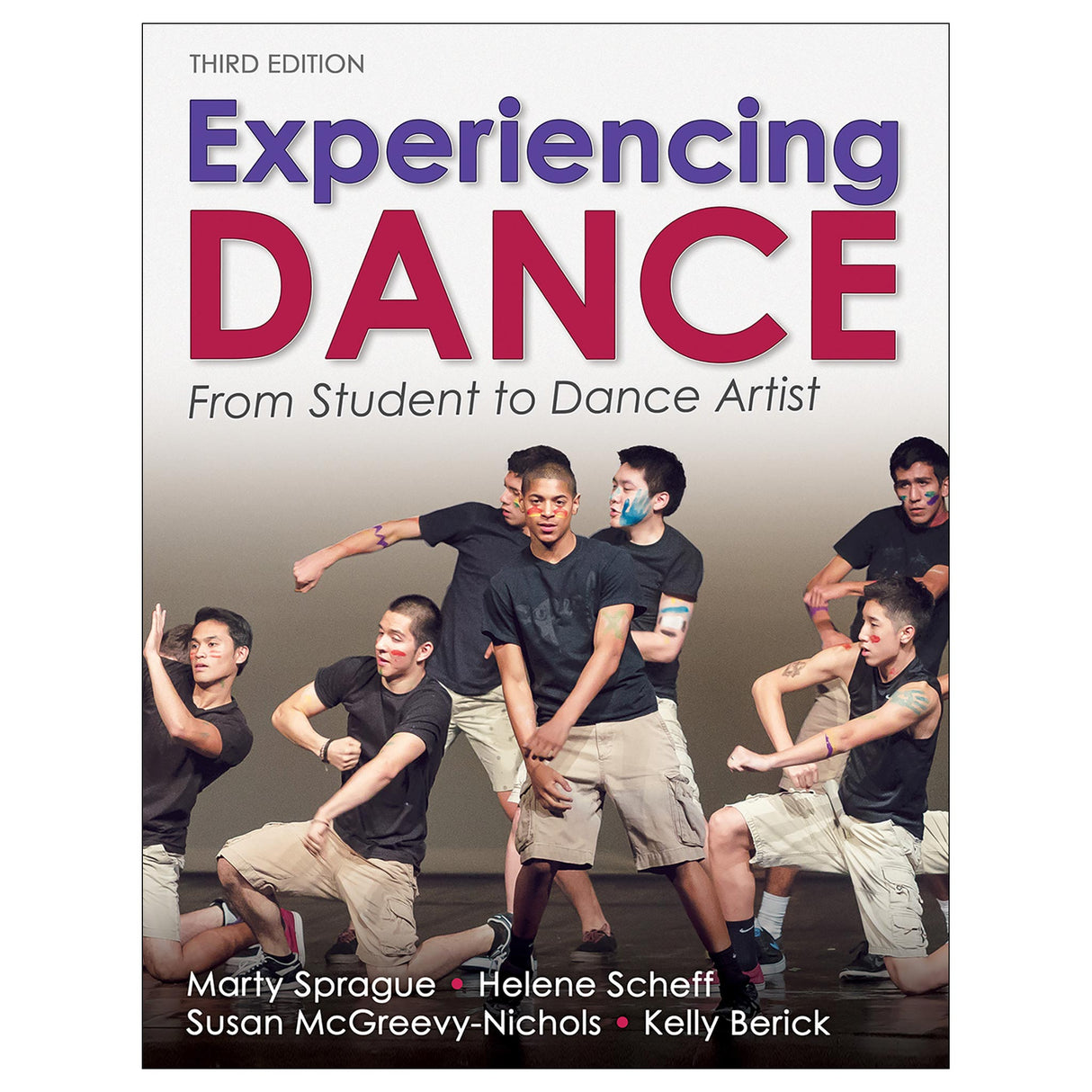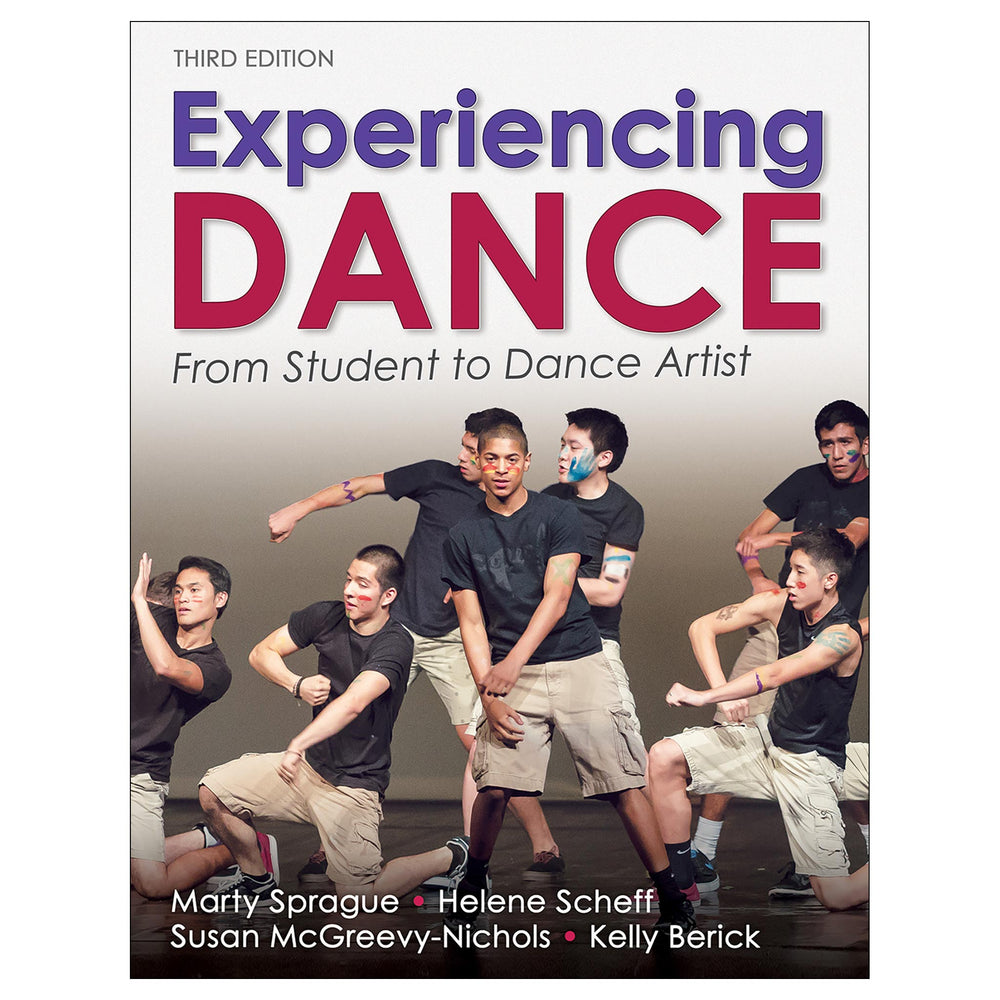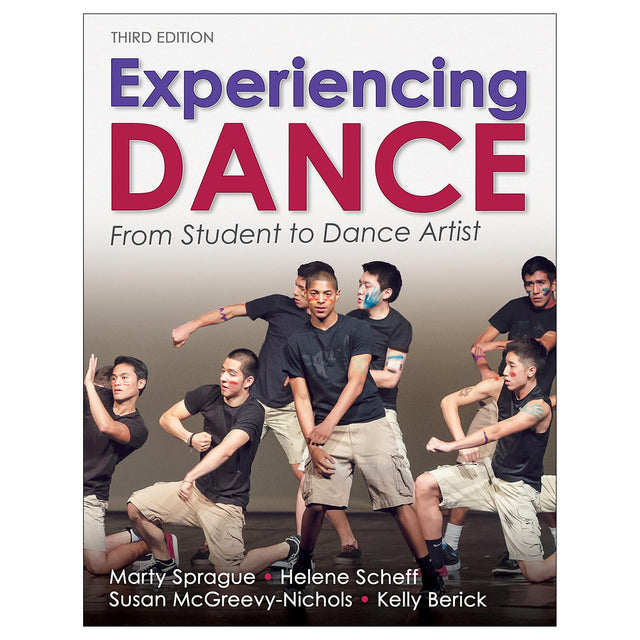Experiencing Dance 3rd Edition
From Student to Dance Artist
$170.95 CAD
Designed to meet national and state dance education standards, Experiencing Dance offers a complete and flexible dance curriculum that will allow students to understand dance through creation, performance, analysis, and response. Whether as performers, choreographers, or observers, students will cultivate a deeper appreciation of dance as they delve into major topics such as these:
- Recognizing movement potential as a dancer
- Understanding dance science and its application through studying basic anatomy and injury prevention in dance training
- Developing proper warm-ups and cool-downs
- Integrating fitness principles and nutrition information into healthy dancing practices
- Exploring dance as an art form—the roles of the dancer, the historical and cultural heritage of the dance, and the dance’s connections to community and society
- Choreographing dance in a variety of styles and forms and incorporating various production elements for the performance
- Preparing for a future as a dancer or choreographer or for a career that is otherwise connected to dance
Experiencing Dance engages students in learning with a mixture of movement and written, oral, and multimedia assignments. Each of the text’s 15 chapters offers at least three lessons, each containing the following sections:
- Move It! introduces students to the lesson through a movement experience; the web resource supplements some activities with video examples.
- Vocabulary provides definitions of key terms.
- Curtain Up offers relevant background information.
- Take the Stage presents dance-related assignments for students to produce and share.
- Take a Bow gauges students understanding of the assignment.
- Spotlight introduces a person, thing, event, or place aligned with the topic.
- Did You Know? offers additional information to enhance overall knowledge.
Note: A QR code for accessing the web resource is included with all print books.
Audience
Textbook for high school dance II, III, and IV courses.Chapter 1. Surveying Your Body at Work
Lesson 1.1 Stand on Your Own Two Feet
Lesson 1.2 Body Mechanics: Matching Movement to Muscles and Bones
Lesson 1.3 Dancing at the Joint
Lesson 1.4 Personal Physical Survey
Chapter 2. Warming Up, Taking Class, and Cooling Down
Lesson 2.1 Your Personal Warm-Up
Lesson 2.2 Dance Class Basics
Lesson 2.3 Stretch What You Strengthen and Cool Down
Chapter 3. Choosing a Dance Form That Suits You
Lesson 3.1 Determine Your Movement Preferences
Lesson 3.2 Recognize Your Physical Traits and Abilities
Lesson 3.3 Connect Your Physical Traits and Abilities With Movement Preferences
Chapter 4. Learning More Than Steps
Lesson 4.1 Develop Thinking Skills Through the Study of Dance
Lesson 4.2 Apply Dance Learning Strategies to Other Life Situations
Lesson 4.3 Explore Careers Beyond Performing
Unit II. Becoming a Dancer
Chapter 5. Diversifying Your Dance Training
Lesson 5.1 Observe and Analyze to Improve Technique in All Dance Forms
Lesson 5.2 Experience and Train in Various Styles and Forms of Dance
Lesson 5.3 Sharpen Your Rehearsal and Performance Strategies
Chapter 6. Improving Your Skills
Lesson 6.1 Find Classes and Teachers Who Meet Your Needs
Lesson 6.2 Share Your Knowledge
Lesson 6.3 Practice Makes Permanent
Unit III. Making Connections Through Dance
Chapter 7. Expressing Ideas and Emotions
Lesson 7.1 Dance as Nonverbal Communication
Lesson 7.2 Dance as a Report or Essay Without Words
Lesson 7.3 Dance as Social Commentary
Chapter 8. Exploring Dance as an Art Form
Lesson 8.1 Differences Between Everyday Movement and Dance
Lesson 8.2 Theatrical Dance
Lesson 8.3 Your Aesthetic Preferences
Chapter 9. Connecting to Community and Tradition
Lesson 9.1 Cultural Dance
Lesson 9.2 Historical Dance
Lesson 9.3 Social Dance
Unit IV. Becoming a Choreographer
Chapter 10. Creating Dances
Lesson 10.1 Choreographic Elements
Lesson 10.2 Choreographic Processes
Lesson 10.3 Choreographic Structures
Chapter 11. Choreographing With a Seven-Step Method
Lesson 11.1 Choose Subject Matter and Explore Movement
Lesson 11.2 Coordinate Music and Movement, Explore Possibilities, Refine, and Memorize
Lesson 11.3 Add Finishing Touches and Perform
Chapter 12. Showcasing Your Work
Lesson 12.1 Costumes and Props
Lesson 12.2 Lighting, Scenery, and Sound
Lesson 12.3 Production Information and Time Line
Unit V. Refining Yourself as a Dance Artist
Chapter 13. Learning From the Works of Others
Lesson 13.1 View, Analyze, Interpret, and Critique Others’ Works
Lesson 13.2 Learn From the Choreography of Others
Lesson 13.3 Improve Your Performance by Watching Others
Chapter 14. Sharing Your Art Form
Lesson 14.1 Create and Plan Presentations for Specific Settings
Lesson 14.2 Find Places to Share Your Presentation
Lesson 14.3 Give Back to Your Community
Chapter 15. Developing Your Portfolio, Résumé, and Audition Skills
Lesson 15.1 Build Your Portfolio
Lesson 15.2 Create Your Résumé
Lesson 15.3 Prepare for Auditions
All ancillaries are free to adopting instructors through HKPropel.
Teacher guide. Includes planning charts that link to all supplemental resources associated with each lesson, a printable full-color poster for the classroom, PowerPoint presentations for each chapter, answer keys for worksheets and quizzes, and a full electronic version of the student textbook.
Test package. Contains questions in true-false, fill-in-the-blank, essay and short-answer, and multiple-choice formats. The files may be downloaded for integration with a learning management system or printed for use as paper-based tests. Instructors may also create their own customized quizzes or tests from the test bank questions.
Chapter quizzes. Contains ready-made quizzes (9-10 questions each) to assess student comprehension of the most important concepts in each chapter.
Presentation package. Features PowerPoint slides of text, artwork, and tables from the book that can be used for class discussion and presentation. The slides in the presentation package can be used directly within PowerPoint or printed to make handouts for students. Instructors can easily add, modify, and rearrange the order of the slides.
Instructors also receive access to the student web resource. For Experiencing Dance, Third Edition, this includes journaling prompts, extended learning activities, web search suggestions for further research, worksheets and assignments to print or complete online (via editable Word files), chapter review quizzes that are completed online and provide immediate feedback, video clips, and vocabulary term flash cards.









